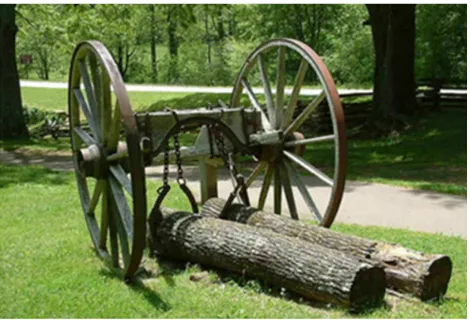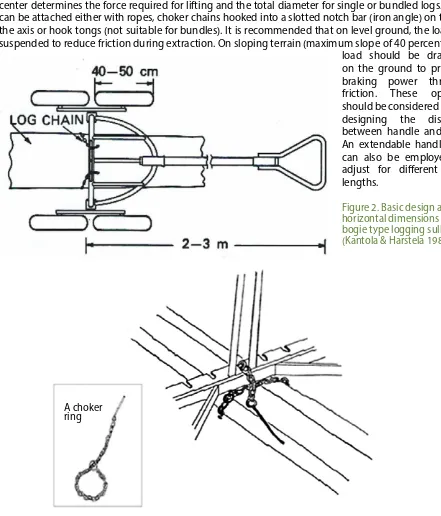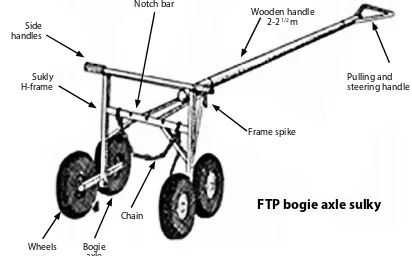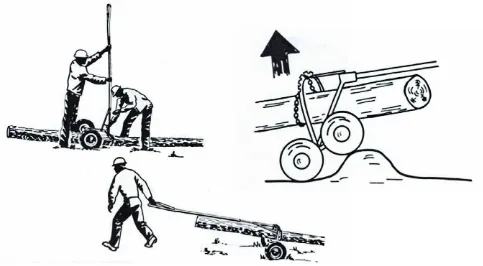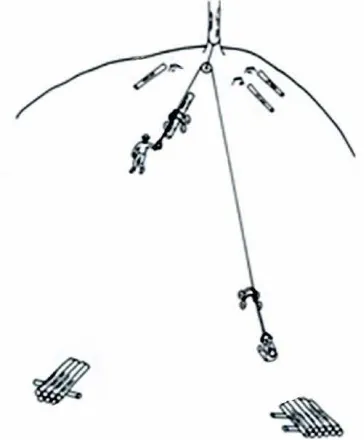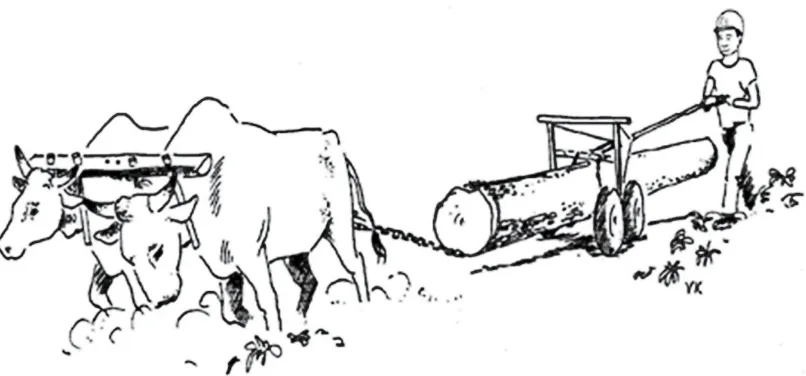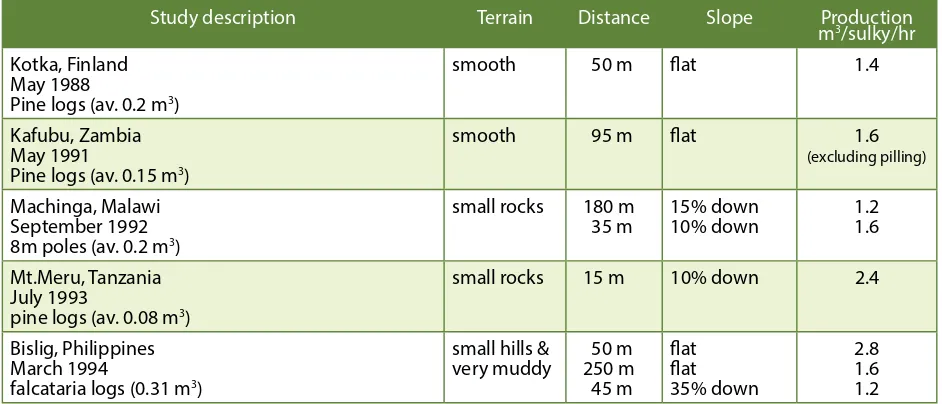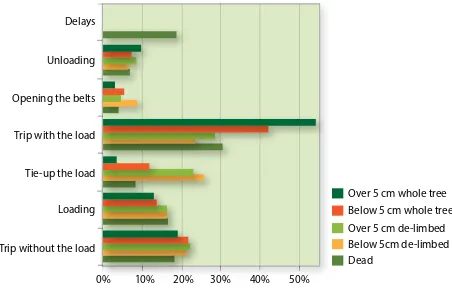2
Manually operated sulkies
RECOFTC - The Center for People and Forests Copyright © RECOFTC December 2015 Bangkok, Thailand
All photos courtesy of RECOFTC except where reference is indicated
Reproduction of this publication for educational or other non-commercial purposes is authorized without prior written permission from the copyright holders provided the source is fully acknowledged. Reproduction of this publication for resale or other commercial purposes is prohibited without written permission of the copyright holder.
This publication has been generously funded by the Ministry for Foreign Afairs of Finland. The views expressed in this publication are those of the authors and do not necessarily relect the views of RECOFTC and our donor organizations.
Table of contents
1. History and development
1
2. Design features
3
3. Other sulky applications
7
3.1 Sulkies for bamboo extraction 7
3.2 Sulkies in manual steep slope extraction 8
3.3 Draught animal sulky 8
4. Productivity and eficiency in sulky extraction of timber
11
4.1 Timber 11
4.2 Bamboo 11
Recommendations 13
References
14
Annex
15
1. Suppliers 15
2. Machine Cost Calculation 16
Figures
Figure 1. Historical logging sulky/arch circa 1900
(www.toolmonger.com/2009/04/14/antiquetools-logging-gear/) 1 Figure 2. Basic design and horizontal dimensions of bogie type logging sulky
(Kantola & Harstela1988) 3
Figure 3. Notch bar for chain attachment with choker coupling (Seymore, M 1996) 3 Figure 4. Commercially produced hand sulky with chain choker system. Note protective angles in
front of the wheels (www.norwoodsawmills.com) 4 Figure 5. Finland training programme (FTP) double wheel bogie sulky
(Seymore, M 1996, Kantola M & Harstela, P 1988) 4
Figure 6. Working with the logging sulky 5
Figure 7. Bamboo sulky. Note the clamping device and the extendable handle bar with an inside
pipe of about 100 cm and the spade-like emergency brake. 8 Figure 8. Use of pulleys combined with counterweights on steep slopes 8 Figure 9. Sulky in combination with draught animals (Seymore 1996) 9
Tables
Table 1. Productivity for two-man sulky teams under diferent site conditions
(Seymore 1996) 11
Table 2. Table 2: Time distribution for sulky extraction of bamboo over 350 meters 12 Table 3. Productivity for two-man teams in relation to bamboo culm characteristics over an
1. History and development
Current logging sulky and logging arch models originated from animal-drawn wooden straight axis logging charts and arches, which were the basic log transport tools in forestry operations until the 1930s when they were gradually replaced by tractor-based systems.
Two-wheeled manual sulkies were developed in the 1970s for use in the tropics by forest development projects of mainly Scandinavian countries. In its inal development stage, a sulky with double bogie wheels was designed in 1985 in Finland and applied widely in east African countries and the Philippines under the FINNIDA APPRODEV project. In recent years, larger- and stronger- framed models have also been developed for tractor and all-terrain vehicle (ATV) operations, which will be covered in a separate factsheet.
Logging sulkies are in most cases the most appropriate systems for improving small scale forwarding operations in smallholder (plantation) and community (natural forest) operations, particularly where animal ex-traction has not been practiced before.
2. Design features
In its basic design, a logging sulky consists of two wheels with a straight or arched axis elevated at least 30 centimeters (cm) above the mid-wheel level. The sulky serves the dual purpose of lifting and transporting (skidding) logs, either in full suspension above ground (see Annex: “Suppliers”: www.mistersawmill.com) or dragging with one-end suspended. The elevation of the ixation point of the log above the wheel center determines the force required for lifting and the total diameter for single or bundled logs. Logs can be attached either with ropes, choker chains hooked into a slotted notch bar (iron angle) on top of the axis or hook tongs (not suitable for bundles). It is recommended that on level ground, the load be suspended to reduce friction during extraction. On sloping terrain (maximum slope of 40 percent), the load should be dragged on the ground to provide braking power through friction. These options should be considered when designing the distance between handle and axis. An extendable handle bar can also be employed to adjust for diferent load lengths.
Figure 2. Basic design and horizontal dimensions of bogie type logging sulky (Kantola & Harstela 1988)
Figure 3. Notch bar for chain attachment with choker coupling (Seymore, M 1996)
4
There are a few manufacturers and international suppliers (see Annex) for logging sulkies. However, transport costs and import taxes will in most cases make importation too expensive. Moreover, the relatively simple design of this equipment can be locally produced by welding shops, which at the minimum, only require gas welding and steel water pipe bending equipment.
Figure 4. Commercially produced hand sulky with chain choker system. Note protective angles in front of the wheels (www. norwoodsawmills.com)
The weight of the sulky is a decisive factor in terms of ergonomics, especially if work will be done on sloping terrain. Harstela (1986) compared the pulling forces of diferent bogie constructions:
(1) Two wheel axle weight of sulky 25 kg 14.5 kp11 pulling force
(2) Two wheel axle weight of sulky 16 kg 12.6 kp (3) Bogie double wheel weight of sulky 35 kg 10.6 kp
Loading capacity is normally around 125 kilogram (kg) for light frame sulkies and 200 kg for heavier frame two-wheel sulkies, while 250 to 300 kg can be loaded on bogie types. For higher loading capacity, the sulky must be equipped with hand winches (see www.mistersawmill.com in the Annex) and adapted to three-to four-person teams. Most studies on hand sulkies indicate that weight (25 vs. 50 kg) will afect productivity (1.6 vs. 1.0 meter (m)3/hour) by as much as 30 percent on gentle slopes(Ole-Meiludie and
Omes1979). Thus, weight limitation is an essential consideration in any sulky design.
3. Other sulky applications
During felling operations, hang-ups (trees entangled in canopy) are the potential death traps commonly encountered by forest workers. Sulkies can provide safe and eicient solutions in such risky situations. After removal (preferably by axe) of the hinge (holding wood between felling sink and back cut), either sulkies with choker chains
or special sulky type felling aids (see Annex: “Suppliers” – Grube-Muenchehof Model) can be used to release and bring down the separated stem along paths that have been carefully cleared in advance.
3.1 Sulkies for bamboo extraction
Extraction of bamboo from secondary unmanaged forests in northern Lao PDR requires a special type of sulky that enables the downhill forwarding of economically viable loads. Such a sulky has to fulill three key requirements:
1. Allow bundling and holding of bamboo culms in loads of up to 250 kg using various suspension positions to accommodate an extendable handle bar (1.0 m extension);
2. Allow high maneuverability of the sulky in-between trees and bamboo clumps along overgrown extraction routes while loaded with culms of up to 15 m in length; and
3. Provide a braking mechanism that allows emergency stops when extracting on steep slopes.
These criteria were addressed with design elements shown in Figure 7. The sulky was manufactured from a small two-wheel (50 cm diameter) axle with a 2.5 m handlebar. In its initial stage, the bar was constructed with an inserted handle that made possible the testing of various bar lengths. A clamp-type holding bank was elevated about 30 cm above the axle and connected with a 10 cm diameter ball bearing on two steel plates with a small center axis that allows free turning of the wheels by more than 90o below the bamboo loads. The clamps have attachment hooks and guide plates on each side of the top section for the attachment of 5 cm-wide ratchet straps for bundling bamboo culms, with these straps allowing readjustment in case the culms slide apart during extraction. The inside of the clamps are covered with consecutive 3x3 cm sharpened teeth to improve grip on the slippery bamboo culms. The clamps and support are made from 6-8 cm x 60 cm steel strips.
A spade-like brake was also attached to the irst upward bend of the handle bar. Simply pressing the handlebar towards the ground on steep and slippery terrain thus makes for safe emergency stops.
8
Figure 7. Bamboo sulky. Note the clamping device and the extendable handle bar with an inside pipe of about 100 cm and the spade-like emergency brake.
3.2 Sulkies in manual steep slope extraction
Hand sulkies reach their ergonomical limits on steeper slopes (above 30o). In such situations, the use of pulleys (for details, please see the hand tool factsheet) as shown in Figure 8 is recommended. Using pulleys will allow either safe downhill extraction with a counterweight or easier uphill movement by using the downhill force of the empty sulky and downhill pulling force of the operators. It is advisable that such systems also adopt the spade-type safety break system as illustrated in the bamboo sulky (Figure 7).
Figure 8. Use of pulleys combined with counterweights on steep slopes
3.3 Draught animal sulky
4. Productivity and eficiency in sulky
extraction of timber
4.1 Timber
Several studies were carried out between 1970 and 1995 by Finland- and Norway-supported projects on hand sulky extraction of timber. The results of some of these studies are summarized in Table 1.
Table 1. Productivity for two-man sulky teams under diferent site conditions (Seymore 1996)
Study description Terrain Distance Slope Production
m3/sulky/hr
small rocks 15 m 10% down 2.4
Bislig, Philippines March 1994
falcataria logs (0.31 m3)
small hills &
The igures in table 1 and some further studies by Skaar (1975), Ole-Meiludie (1984) and Saarilahti (1992) illustrate skidding outputs in relation to extraction distances (moderate slopes) for two-man sulky skidding teams on prepared trails with average loads of 100-200 kg.
Skidding distance (m) 10 40 80 Skidding output (m3/ day) 12-18 8-13 5-10
Labour productivity (m3/person/day ) 6-9 4-6.5 2.5-5
4.2 Bamboo
12
The bamboo sulky was developed to carry loads exceeding 200 kg. In its original design, its weight was over 85 kg. A lighter version is currently being built. According to the opinion of the operators used in the Salakka (2014) study, a load size of 120 kg is ergonomically suitable when two operators are pulling the sulky. The forwarding distance used in the trial cycles was 350 meters. Topography was moderately sloped (20 percent) along the extraction route and lat (15 percent maximum) with soft ground on paddy terraces. Table 2 gives the time breakdown of activities in bamboo extraction. In comparison to timber extraction, the loading time was around 20 to 30 percent higher, attributed to the smaller size of the material being loaded. Pre-bundling of bamboo culms, which reduces cycle time, was not possible due to the top loading character of the clamp bank.
Table 2: Time distribution for sulky extraction of bamboo over 350 meters
Table 3: Productivity for two-man teams in relation to bamboo culm characteristics over an extraction distance of 350 meters
Productivity, t/h Average load, kg Average cycle time, min
Dead 0.283 134 28.4
Below 5 cm de-limbed 0.302 106 21.1 Over 5 cm de-limbed 0.467 155 20.0 Below 5 cm whole tree 0.236 85 21.5 Over 5 cm whole tree 0.200 84 25.3
Given the extraction distance and the extremely low range of volume (weight-piece ratio of 8-20 kg per piece, productivity igures are surprisingly high compared to timber (50-200 kg per piece). In terms of labor productivity, extraction will be in the range of 0.8-2.0 tons/person/day. Given site conditions, the use of the sulky increases labor productivity in bamboo extraction by at least three to ive times compared to carrying by hand.
Over 5 cm whole tree Delays
Below 5 cm whole tree Over 5 cm de-limbed Below 5cm de-limbed Dead
Recommendations
14
References
Abeli, W S 1992, “Optimal road spacing for manual skidding sulkies,” Journal of Tropical Forest Science, Vol. 6, Np. 1, pp. 8-15.
FAO 1989, “Design manual on basic wood harvesting technology,” FAO Training Series No. 18, pp. 11-17, http://www.fao.org/docrep/016/t0129e/t0129e.pdf.
Fosser, E 1974, “The sulky: a working aid in conifer plantations,” NORAD TAN/70/005, Oslo. Fosser, E 1976, Terminal reports on skidding sulkies, NORAD report, Oslo.
Fosser 1976, Manual for logging sulkies: A working aid in softwood plantations, NORAD, Oslo.
Harstela, P and Harstela, A 1986, A pre-study of skidding sulkies, Finnish Forest Research Institute, Suonenjoki Research Station.
Kantola, M and Harstela, P. 1988, Handbook on appropriate technology for forestry operations in developing
countries, Forestry Training Program, Publication 19, Chapter 6.4 Sulky skidding, pp. 94-97.
Mboya, G P E 1985, Factors inluencing production rates in sulky skidding, Special project report Faculty of Forestry, Sokoine, University of Agriculture, Morogoro, Tanzania.
Ole-Meiludie, R E L and Omes, H 1979, The use of sulkies in thinning softwood plantation, University of Dar es Salaam, Divison of Forestry, Morogoro, Record No. 9, p. 13.
Saarilahti, M 1992, Skidding by sulky, A literature study, Silva Fennica, (26): 85-96.
Salakka, J 2014, Identifying appropriate small scale harvesting technologies for commercial scale bamboo
buel chip production in Lao PDR, Bachelor thesis, Karelia University, pp. 64.
Seymore, M 1996, The Sulky, APPRODEV Reference Manual Part 3, FTP International Training Materials, Helsinki, Finland, pp. 35.
Skaar, R 1973, Skidding of saw logs from conifer thinning with a locally made skidding cart, a pilot study, Makerere University, Deptartment of Forestry, Kampala Report 01-73, pp. 18.
Skaar, R 1981, The use of hand sulkies in logging, Proceedings of the XVII IUFRO Congress Division 3 Kyoto, Japan.
Annex
1. Suppliers
www.hakmet.com (Canada)
www.grube.de (Germany)
www.hakmet.com (Canada)
www.norwoodsawmills.com (Please see Figure 4).
16
2. Machine Cost Calculation
Manufacturer: ______________________________ Model: ____________________ HP: _________________________
Purchase price:
Total price of transportation to site:
Total:
$ ______________________________
$ ______________________________
$ ______________________________
(P) INITIAL INVESTMENT $_________________
(S) Salvage Value (____% of P) $_________________
(N) Estimated Life: ____ years
(SH) Scheduled operating time: ___ hrs/yr
(U) Utilization: ___ %
(H) Productive time ____ hrs/yr
(AVI) Average value of yearly investment
AVI = [((P-S)(N+1))/2N]+S $_________/yr
I. Fixed cost:
Depreciation= (P-S)/N $_______/yr
Interest (____ %), Insurance (____ %), Taxes (____ %)
Total ____ % x ($____/yr) $_______/yr
(1) Fixed cost per year $_______
(2) Fixed cost per H (1÷H) $_______
II. Operating cost: (based on productive time)
Maintenance and repair (_____% x ((P-S)/(N x H)) $_______
Fuel (____ L x $____/L) $_______
Oil & lubricants $_______
Tires (1.15 x (tire cost)/tire life in hrs.) $_______
(3) Operating cost per H $_______
III. Machine cost per H (without labor) (2+3) $_______
IV. Labor cost ($_____/hr ÷U) $_______
18
RECOFTC’s mission is to enhance capacities for stronger rights, improved governance and fairer beneits for local people in sustainable forested landscapes in the Asia and the Paciic region.
RECOFTC holds a unique and important place in the world of forestry. It is the only international not-for-proit organization that specializes in capacity development for community forestry. RECOFTC engages in strategic networks and efective partnerships with governments, nongovernmental organizations, civil society, the private sector, local people and research and educational institutes throughout the Asia-Paciic region and beyond. With over 25 years of international experience and a dynamic approach to capacity development – involving research and analysis, demonstration sites and training products – RECOFTC delivers innovative solutions for people and forests.
